Nobody Who Went on This Camping Trip Will Ever Feel the Same About Sleeping in own Bed Again 1
What really happens when babies are left to weep it out?

Some parents see "sleep training" as the key to a good nighttime'southward rest. Others argue that it's distressing for babies. What do scientists say about its risks and benefits?
I
In 2015, Wendy Hall, a paediatric sleep researcher based in Canada, studied 235 families of six- to eight-month-old babies. The purpose: to encounter if sleep preparation worked.
Past its broadest definition, sleep training tin refer to any strategy used by parents to encourage their babies to slumber at night – which can be as simple every bit implementing a nighttime routine or knowing how to read an infant's tiredness cues. Tips like these were an of import part of Hall'southward intervention.
So was a strategy that has become commonly associated with "sleep training" and tends to be far more than divisive: encouraging babies to put themselves to sleep without their parents' help, including when they wake up at dark, by limiting or changing a parent's response to their child. This may mean a parent is nowadays, but refrains from picking up or nursing the baby to physically soothe them. It can involve set up fourth dimension intervals where a baby is left alone, punctuated by parent bank check-ins. Or, in the cold-turkey arroyo, it may mean leaving the infant and shutting the door. Any of these approaches ofttimes mean letting the baby cry – hence the common, if increasingly unpopular, moniker "cry-it-out".
In global terms, the idea of "training" babies to sleep alone and unaided is uncommon. Modern Mayan mothers, for example, expressed shock when they heard that in the The states, babies were put to slumber in a separate room. Just in North America, Commonwealth of australia and parts of Europe, many families swear by some class of the technique. Parents can exist particularly willing to give it a shot when cleaved nights brainstorm to bear upon the entire family unit's wellbeing – poor infant sleep is associated with maternal depression and poor maternal wellness, for example. In the US, more than half dozen in 10 parenting advice books endorse some form of "cry-information technology-out". Half of parents who responded to questionnaires in Canada and Australia and one-third of parents surveyed in Switzerland and Deutschland said they've tried it (although the surveys are not necessarily representative of parents equally a whole in these countries, due to the way they were conducted). Around the world, an entire industry is devoted to helping parents slumber train.
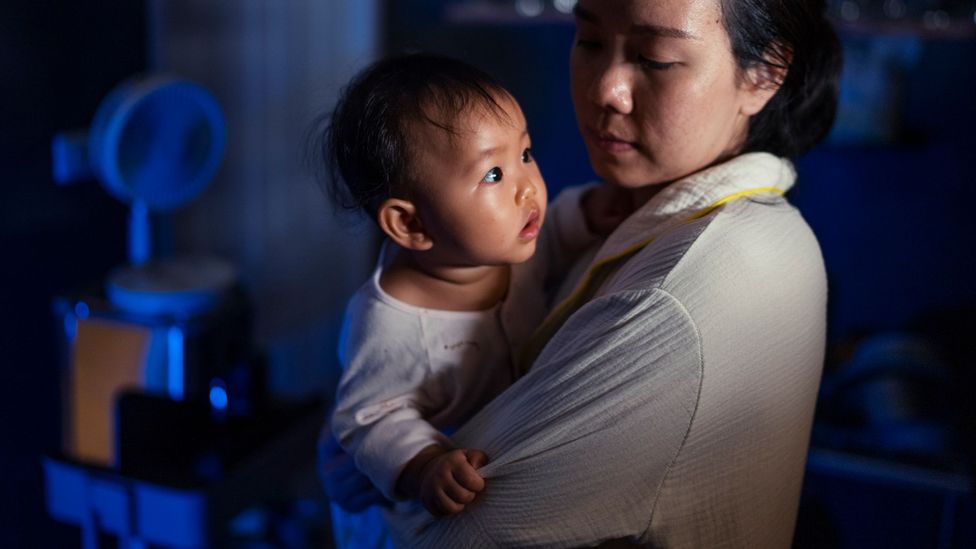
A baby'south disrupted sleep tin can affect the whole family (Credit: Getty Images)
In their study, Hall and her team predicted that the babies whose parents were given instructions for slumber training along with advice would slumber amend after six weeks than those who were not, with "significantly longer longest sleep periods and significantly fewer night wakes".
This would exist in line with existing findings. Dozens of studies say they accept establish slumber interventions effective; paediatricians routinely recommend slumber training in countries like the United states of america and Commonwealth of australia (although infant mental health professionals often do not). However, enquiry is never perfect, and many of those prior studies had attracted some criticism – which Hall was hoping to address.
For ane, relatively few studies on sleep training have met the gold standard of scientific enquiry: trials where participants are randomly allocated to receiving the intervention, that have a control grouping that did not receive the intervention (especially important with sleep inquiry, since about babies naturally slumber in longer stretches over time), and that have enough participants to detect effects.
A number of studies, for case, have been non-randomised, with parents deciding on the method of treatment themselves. This makes it difficult to prove crusade and effect. For instance, parents who take reason to think their babies will but weep for a short while (or non at all), then autumn asleep, may be more open to trying out controlled crying to begin with – which could skew results to make information technology seem more effective than it is. Alternately, it could exist parents whose babies really struggle to autumn comatose past themselves that are more fatigued to the method, making it look less effective than it is. And, of course, the difficulty of studying something like sleep training is that even in a randomised trial, parents assigned a controlled crying method may decide against it – so a "perfect" written report is impossible to set up. Many trials often have high drop-out rates, meaning parents who constitute sleep grooming especially difficult may not have their experiences reflected in the results.
Meanwhile, the majority of studies rely on "parent report", such as questionnaire responses or sleep diaries kept by the parents, rather than using an objective measure to determine when a babe is awake or asleep. Just if a child has learned not to cry when he wakes, then his parents might not wake, either – which could lead them to report that their child slept through the night regardless of what happened.
In that location is besides the problem of confirmation bias: if parents expect an intervention to help their kid'south sleep, then they may be more probable to see that child'south slumber as having improved later on an intervention.
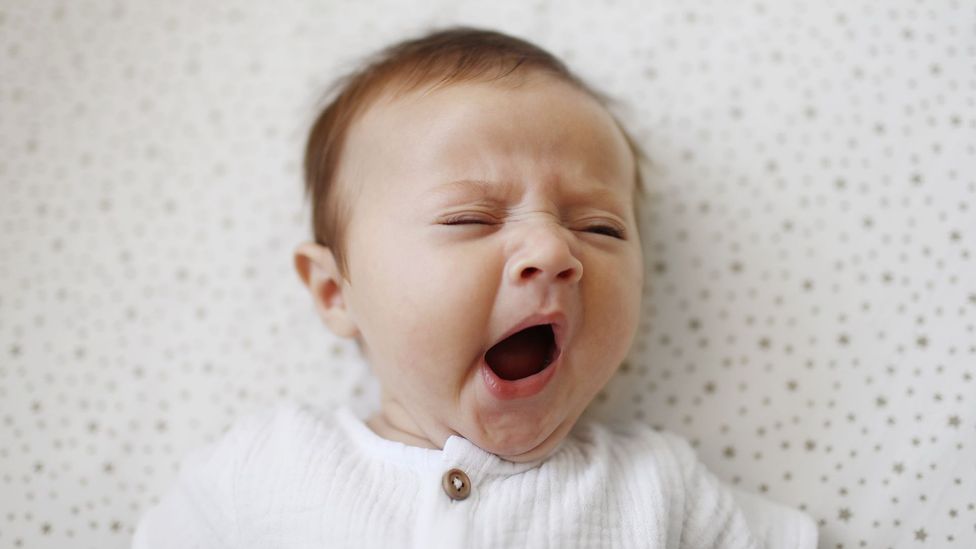
If a child has learned not to cry on waking, parents may mistakenly believe that she's slept through the night (Credit: Getty Images)
Hall'due south study – involving 235 babies and their parents – was designed to answer to some of these criticisms. As a randomised controlled trial, one-half of the parents were instructed in what'due south called either "graduated extinction", "controlled comforting" or "controlled crying": soothing a crying baby for short increments, then leaving them for the aforementioned amount of time, with intervals gradually getting longer regardless of the child'south response. For parents who were "really uncomfortable" leaving their child crying alone in the room, Hall says, the researchers brash staying in the room – but not picking the kid upward – in an approach called "camping ground out".
The intervention grouping also received tips and information near baby slumber, such as myth-busting the idea that fewer naps would lead to more than nighttime sleep. (Information technology's worth noting that this mix of a controlled crying method with other communication is common in studies examining slumber training, but makes information technology more difficult to parse which, if any, results are from the controlled crying alone.) To ensure both groups received some kind of instruction, the command group parents received information about infant safety.
As well as asking parents to tape sleep diaries, Hall's study included actigraphy, which uses habiliment devices to monitor movements to assess sleep-wake patterns.
When the researchers compared sleep diaries, they found that parents who had sleep-trained thought their babies woke less at dark and slept for longer periods. Only when they analysed the sleep-wake patterns equally shown through actigraphy, they found something else: the sleep-trained infants were waking up but every bit often as the ones in the control grouping. "At six weeks, there was no difference betwixt the intervention and control groups for mean modify in actigraphic wakes or long wake episodes," they wrote.
In other words, parents who slumber-trained their babies idea their babies were waking less. But, according to the objective slumber measure, the infants were waking just as often – they merely weren't waking up their parents.
To Hall, this shows the intervention was a success. "What we were trying to do was help the parents to teach the kids to self-soothe," she says. "So in issue, nosotros weren't saying that they wouldn't wake. Nosotros were proverb that they would wake, but they wouldn't have to signal their parents. They could go back downwardly into the next sleep bicycle."
The actigraphy did discover that sleep preparation improved 1 measure of the babies' slumber: their longest sleep menstruation. That was an improvement of 8.5%, with sleep-trained infants sleeping a 204-minute stretch compared to 188 minutes for the other babies.
Some other office of her hypothesis too proved correct. Her team expected that parents who did the intervention would report having improve moods, higher-quality sleep and less fatigue. In a finding that won't surprise anyone who has rocked or nursed an infant to sleep several times a night, this proved to be true – and, for many experts and parents, is a cardinal upside of sleep training.
But for anyone who has ever read, Googled, or been served social media ads about infant sleep, the fact that sleep training researchers believe training isn't meant to reduce the number of times a baby wakes – and that information technology might extend their longest slumber stretch past an boilerplate of only 16 minutes – might come every bit a surprise.
The origins of "weep it out"
Slumber preparation is a relatively new phenomenon, even in countries where it is at present quite common. Every bit BBC Future has covered before, earlier the 19th Century, new parents didn't seem to exist peculiarly concerned about their infants' sleep. This inverse equally the Industrial Revolution brought longer piece of work days and as the Victorian era emphasised independence, even among babies.
In 1892, the "father of paediatrics", Emmett Holt, went so far as to argue that crying alone was expert for children: "in the newly born infant, the cry expands the lungs", he wrote in his popular parenting transmission The Care and Feeding of Children. A babe "should simply be allowed to 'cry it out'. This often requires an hour, and in extreme cases, two or three hours. A second struggle volition seldom concluding more than 10 or 15 minutes and a 3rd will rarely be necessary."
It wasn't until the 1980s, however, that the first official weep-information technology-out "programmes" were introduced. In 1985, Richard Ferber advocated what he called the "controlled crying" or "graduated extinction" method, letting a child cry for longer and longer periods. (He subsequently said he'd been misunderstood and, contrary to popular belief, that he wouldn't propose this arroyo for every child that doesn't sleep well.) In 1987, Marc Weissbluth advised just putting the infant in his crib and closing the door – dubbed "unmodified extinction".
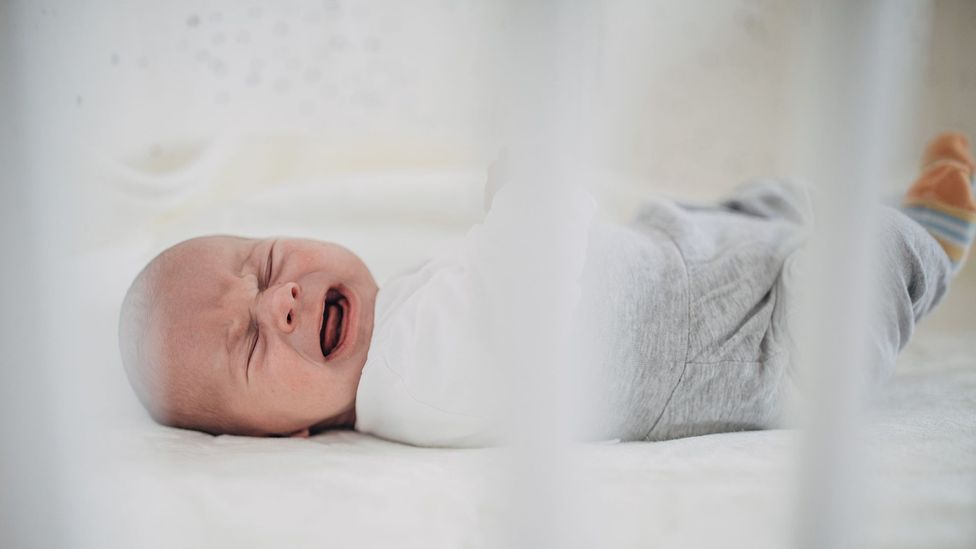
While some books suggest a form of controlled crying even for newborns, about slumber researchers caution against it (Credit: Getty Images)
With some variations, these are largely the versions of slumber preparation that accept persisted, with 1 2006 report of forty popular parenting books finding that twice equally many promoted weep-it-out as opposed information technology. Some books propose following some grade of controlled crying even for newborns.
It'due south worth noting that even researchers who advocate for sleep interventions, including Hall, think starting then young – any time earlier six months old, in fact – is a mistake. They besides say they would not recommend sleep preparation for children who could exist more than prone to psychological damage, including babies who have experienced trauma or been in foster intendance, or babies with an anxious or sensitive temperament. (Breastfeeding mothers have an additional reason to wait until half dozen months to sleep railroad train, say lactation experts, since early on night-weaning may reduce supply.)
Slumber preparation strategies for babies under half dozen months old are unlikely to work in whatsoever case, researchers have plant. "The conventionalities that behavioural intervention for sleep in the showtime half dozen months of life improves outcomes for mothers and babies is historically constructed, overlooks feeding problems, and biases interpretation of data," one review of 20 years' worth of relevant studies put it. "These strategies have not been shown to decrease infant crying, prevent sleep and behavioural problems in later childhood, or protect against postnatal depression."
In addition, the researchers wrote, these strategies hazard "unintended outcomes" – including increased crying, an early on cease to breastfeeding, worsened maternal anxiety, and, if the infant is required to sleep either day or night in a separate room, an increased chance of Sudden Infant Death Syndrome (SIDS).
Hall once received a phone call from a concerned grandmother, she says, saying that her son and his wife had taken their 3-month-old to a slumber trainer. "The sleep trainer had been basically really hard line, and this kid was now vii months old and was having huge attachment issues," Hall says. "I but wrote her back and said, no one should always do that to a iii-month-old. They don't have object permanence, they don't know that if you're not in the room you haven't disappeared from the planet. It'due south psychologically dissentious.
"And this is the trouble with having a lot of people out there who just put upward a shingle and start working with parents and telling them what they should or shouldn't exercise, without an understanding of what they're potentially doing to these babies."
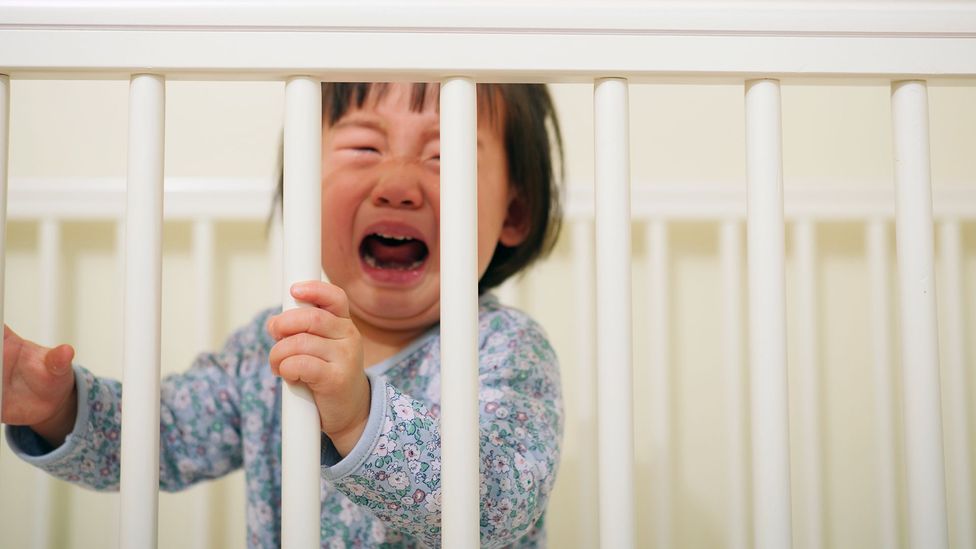
For some babies, at that place are no tears, while for others, it tin be hours of crying (Credit: Getty Images)
Older babies' reactions tin vary. For some, tears are cursory or non-existent. For others, it can be hours of crying, even to the point of vomiting (common enough to exist a frequent topic of conversation on slumber-training forums and addressed by baby slumber books including Ferber'southward). And while methods like camping ground out – where parents stay in the room but don't pick up, nurse or cuddle the babe – often are considered gentler, they can upset and confuse some babies more than harder-line strategies and tend to accept longer.
Either way, many parents experience sleep preparation is a necessary rite of passage – not only to get a good night's slumber themselves, just because they're told that their babies will slumber improve, longer and more deeply, and that they need this to thrive. This refrain is particularly common in the world of sleep coaching, an unregulated industry where consultation fees tin can exist hundreds of dollars.
But that's not quite what the inquiry shows.
Crying it out – merely notwithstanding waking up
I of the few long-term studies done on slumber training, for instance, compared viii-month-quondam babies who were trained using controlled crying (waiting longer and longer before responding to cries), or camping out (sitting with the baby until they fall asleep without picking them up, and gradually moving further and farther abroad), versus continuing to reply to their babies as normal. All of the babies in the trial, conducted in Australia, were described by their mothers as having slumber problems.
In questionnaires they filled out, some of the mothers did study that sleep preparation helped their babies in the brusk term. Merely not all. Lxxx-4 per centum of those who used controlled crying, and 49% of those who used camping out, said those approaches were helpful. (Information technology'southward also worth noting that the intervention that the most mothers rated highest was very dissimilar: "having someone to talk to", seen as helpful by 95%.)
And for those who did observe a grade of sleep training helpful, furnishings didn't necessarily last. Two months after the intervention, when the babies were 10 months old, 56% of sleep-preparation and 68% of the other mothers reported that their babies still had slumber bug. When the infants were 12 months, 39% of sleep-training versus 55% of the other mothers did.
This doesn't just mean that sleep training may not work for every baby. Information technology besides means that, for the families which did notice sleep training constructive, it often needs to be repeated for the furnishings to last. This is backed up by other research: one Canadian questionnaire found that, on average, parents tried controlled crying between two and five times in their infant's offset year.
Longer-term, the Australian written report found that any parent-reported improvements in sleep from sleep training disappeared past age two.
When the children were vi years old, the researchers establish no difference on any measure – negative or positive – between those who were sleep trained and those who weren't, including in their sleep patterns, behaviour, zipper, or cortisol levels.
"What we establish was no difference to children'southward sleep, no difference to children'due south behaviour, and parents were no more than harsh, calumniating or disengaged from their children," says Harriet Hiscock, ane of the study'south authors and a fellow at Australia'south National Health and Medical Research Quango.
The study's finding that sleep training can reduce slumber problems for some families in the curt term, meanwhile, is consistent with a large trunk of research. I administrative 2006 review of 52 studies found that more than lxxx% of children who received an intervention (including strategies other than cry-it-out methods, like implementing a bedtime routine) demonstrated "clinically pregnant improvement that was maintained for three to six months".
But there was no objective sleep measure out used in more 77% of the studies included in the 2006 review – part of the reason why, of the 52 studies reviewed, the researchers considered only 11 of them to have high-quality information. There besides was no objective measure used in Hiscock's written report. Equally ane review of slumber preparation research put it, "in that location are weaknesses" fifty-fifty in many of the randomised controlled trials, "as many intervention studies have used parental reports, questionnaires and diaries, and non objective measurements such as actigraphy information, as outcomes".
Research conducted with an objective measure out such as actigraphy, on the other hand, has found no real difference in sleep between infants that were sleep-trained and those who were not. Hall'southward study is non the only one. One Canadian report of 246 mothers and their newborns constitute "no significant differences" in number of wakes or amount of slumber between the infants whose mothers received information on strategies to optimise their babies' sleep, and those who did not. Interestingly, the mothers received this advice slept just half dozen minutes longer than those who did not. A study of 802 families in New Zealand establish that, there was "no significant intervention upshot on sleep outcomes" at six months, with dark wakes reducing by eight% and sleep duration increasing by six minutes in babies who were left to fall asleep independently, compared to babies who were rocked or fed to slumber.
And i very small-scale written report of 43 infants which compared iii groups – controlled crying, bedtime fading (where babies are put to bed so late that they driblet off easily, with bedtime then being brought forward gradually), and a control group – was widely reported when information technology was published equally showing slumber training to exist successful, with parents in the non-command groups reporting that their babies woke less and slept longer. But, again, that wasn't found with an objective measure. As the report's authors noted, "no significant slumber changes were plant by using objective actigraphy, suggesting slumber diaries and actigraphy measure dissimilar phenomena (eg, infants' absence of crying past parents vs infants' movements, respectively), further suggesting infants may nonetheless experience wakefulness just do non signal to parents".
Sleep researcher Jodi Mindell, associate director of the Sleep Center at the Children'south Hospital of Philadelphia and a proponent of sleep training herself, says the reason for this is simple: sleep training's main goal is not to go along babies from waking, or to help them get more than sleep. It'due south to teach them to go back to sleep by themselves, rather than waking their parents.
"All babies wake ofttimes during the night. It's but whether or not they accept the skill to fall back to sleep independently," she says.
"I don't expect babies to wake less oftentimes. I don't e'er expect that they're going to sleep more on an objective measure."
These frequent wakes may be tough on parents, but they play an important role in keeping babies prophylactic and good for you. As we've covered previously, babies have evolved to wake often for nutrition, caregiving and their own protection, including against SIDS.
Even when done as a randomised controlled trial with an objective measure, meanwhile, sleep training research has other challenges. In that location is some show, for example, that trial participants may feel more pressure level to follow through a slumber intervention than they would otherwise, raising questions about how applicable these findings are to everyday parents – a phenomenon that is hardly unique to paediatric slumber research.
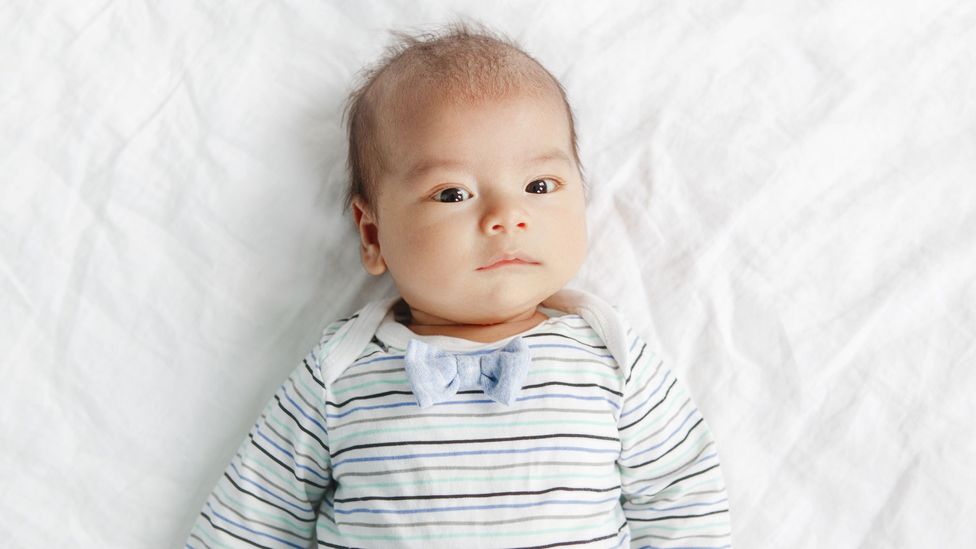
Frequent wakes may be tough on parents, but they play an important role in keeping babies safe and healthy (Credit: Getty Images)
Take the questionnaire in Canada: but 14% of parents reported that controlled crying eliminated all night wakings, and near one-half said information technology didn't reduce wakings at all – results, the researchers wrote, which bespeak "that parents in the community are experiencing considerably less success with graduated extinction than parents in clinical/inquiry setting".
The discrepancy makes sense, especially if you consider that many of these trials have been run by slumber clinics or their researchers, says Helen Ball, the director of the Durham Infancy and Sleep Centre, professor of anthropology at Durham University and a long-time critic of weep-information technology-out methods of sleep preparation. "The people who run those trials have a detail mindset," she says – for example, that sleep preparation works – which may translate to study participants being more committed to the intervention.
"I'm e'er somewhat sceptical that the data that these studies produce are really applicable to existent life."
Soothed or stressed?
If sleep-trained babies are withal waking frequently, but not crying or signalling, this points to a different debate at the center of sleep training. When they wake, are these babies actually learning to calm themselves down from a stressed state (emotionally "self-regulating")? Or are they only as stressed and in need of caregiving when they wake, but have simply learned that if they cry, no one will respond?
Many slumber preparation researchers firmly believe the former. "Don't underestimate the abilities of children to cocky-regulate," says Hall, the paediatric sleep researcher who used actigraphy in her written report of 235 Canadian families. "Parents can help them larn to self-regulate by giving them opportunities to self-regulate. That'southward how you tin look at self-soothing – it'south an opportunity to calm themselves down."
It'south difficult to measure objectively whether babies are truly soothing themselves, or take only given up calling for help.
I way could be to mensurate cortisol, which is frequently known as the stress hormone. But cortisol rises and falls in response to factors also stress, and the studies that have measured it have had mixed results. One found that the babies' cortisol levels were elevated right later on a slumber intervention, just there was no control group of united nations-trained babies to compare it to. The small study of 43 infants found that cortisol declined, but it didn't mensurate cortisol until a week after the intervention. And in an attempt to find out whether sleep grooming led to elevated stress levels long-term, a tertiary study, Hiscock's longitudinal study in Australia, took cortisol samples five years later and found no difference between the cohorts.
"I personally have an issue with the cortisol studies," says Mindell. "Cortisol changes throughout the day. Even sampling cortisol is very hard. It's based on many things, including how many hours a person has been awake, how information technology's sampled – it's a complicated thing. People often call back 'oh, if we mensurate cortisol, nosotros'll know if the baby's stressed or not stressed'."
Fifty-fifty the term "cocky-soothing" has a confusing history. Coined by sleep researcher Thomas Anders in the 1970s, it'due south often used synonymously with the idea that babies can self-regulate. For Anders, nevertheless, a self-soothing baby was simply one who put themselves back to sleep without parental intervention – he wasn't trying to quantify their stress levels.
Of the few studies that have looked at the short- to longer-term outcomes of sleep training, none have plant an effect on a infant's attachment or mental wellness. Hiscock'southward study, for example, the largest and longest longitudinal report washed on slumber training, establish sleep-trained children were no more likely to exist insecurely attached to their caregiver at half-dozen years of age than their peers. (Experts like Hiscock say they aren't aware of whatsoever studies that look at potential long-term effects of common cold-turkey cry-it-out, only at modified extinction. They as well examined good for you babies at least six months old. So these findings aren't necessarily applicable to infants trained at younger ages, or in other means.)
Similar other longitudinal studies, Hiscock'southward lost impact with a number of families when information technology was fourth dimension for the final follow-up: 101 of the original 326. That means it is theoretically possible that the sleep training did bear on some children in either a negative or positive fashion long-term, just that their experiences weren't captured. Information technology's more probable, though, that any effects of a unmarried intervention simply "done out" later six years, says Hiscock.
The upsides of responding
Another mode to examine the cocky-regulation question is to consider babies' developing brains – and their limitations. Human babies are born very neurologically immature compared with other mammals, with brains around ane-third of the size of an developed'southward. The prefrontal cortex, the "dwelling house" of emotional regulation in the brain, is one of the last parts of the brain to mature, non developing fully until i's mid-20s.
Every bit a upshot, throughout infancy and toddlerhood, the brain relies on "co-regulation" – the aid of a soothing caregiver – to at-home down. In a position adopted by the American Academy of Pediatrics, for example, the National Scientific Quango on the Developing Kid defines a "positive" stress response as one that results from stress that is cursory, "mild to moderate" and which hinges on "the availability of a caring and responsive adult who helps the child cope with the stressor, thereby providing a protective upshot that facilitates the return of the stress response systems back to baseline status".
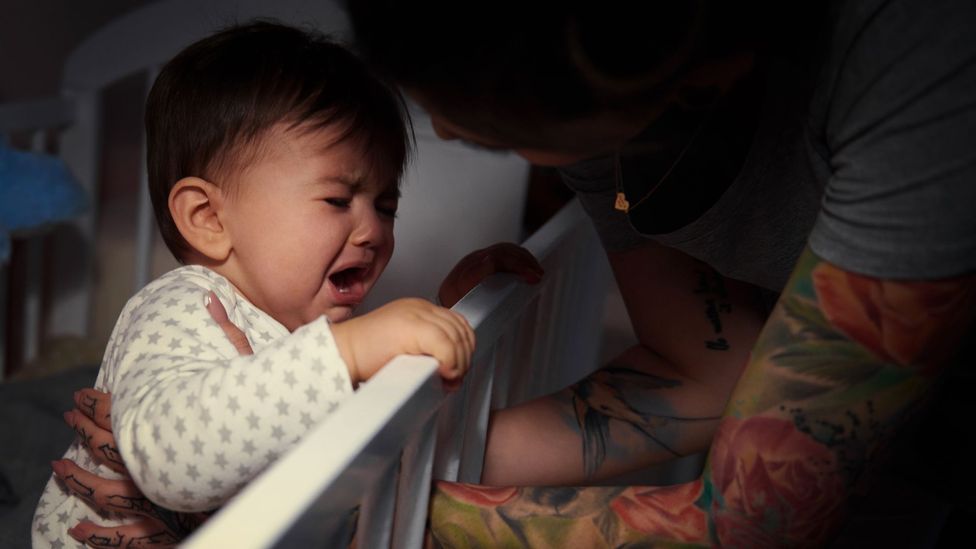
Throughout infancy and toddlerhood, the brain relies on "co-regulation" – the help of a soothing caregiver – to calm down (Credit: Getty Images)
In detail, one of the most crucial periods for developing emotional regulation is from half-dozen to 12 months, says Dan Siegel, clinical professor of psychiatry at the University of California, Los Angeles' Schoolhouse of Medicine and author of numerous books on child development including The Whole-Brain Kid. "The second half of the first year of life is a big moment of learning to regulate yourself," he says. For that reason, he says, at that place may be an statement for waiting at least until after the offset year to sleep railroad train.
While cortisol measurements need to be taken with a grain of salt, scientists indicate out that studies consistently bear witness that babies of less responsive parents take college cortisol levels, particularly afterward a stressful event. Researchers have plant, for example, that newborns whose mothers were more "sensitive" to them during a bath – divers as being enlightened of, and responding appropriately and promptly to, an baby'due south communications – meliorate regulated their cortisol levels when they were taken out. The cortisol levels of 7-month-olds with less sensitive mothers also took longer to regulate after a stressful situation.
This is no less true overnight. One written report found that responding to three-, half-dozen- and 9-calendar month-sometime infants overnight was associated with lower infant cortisol levels. Another plant that the young infants of mothers who were emotionally bachelor at bedtime – including responding to their babies inside 1 minute of crying – had lower cortisol levels than babies of less responsive mothers (though, once again, we need to be cautious nearly over-interpreting the significance of cortisol findings). "Because infants may be especially tired at bedtime, they may have reduced tolerance for stress and therefore require additional aid in regulating their emotions," the researchers wrote. "Thus, parents' ability to soothe their children and create a quiet, safe environment which allows them to fall asleep may exist peculiarly relevant to babe regulatory processes such equally cortisol secretion."
Meanwhile, a big torso of research has shown that a caregiver's consistent responsiveness is "most often associated with language, cognitive and psychosocial development", including improve language acquisition, fewer behavioural issues and less assailment, college intelligence and more secure attachment.
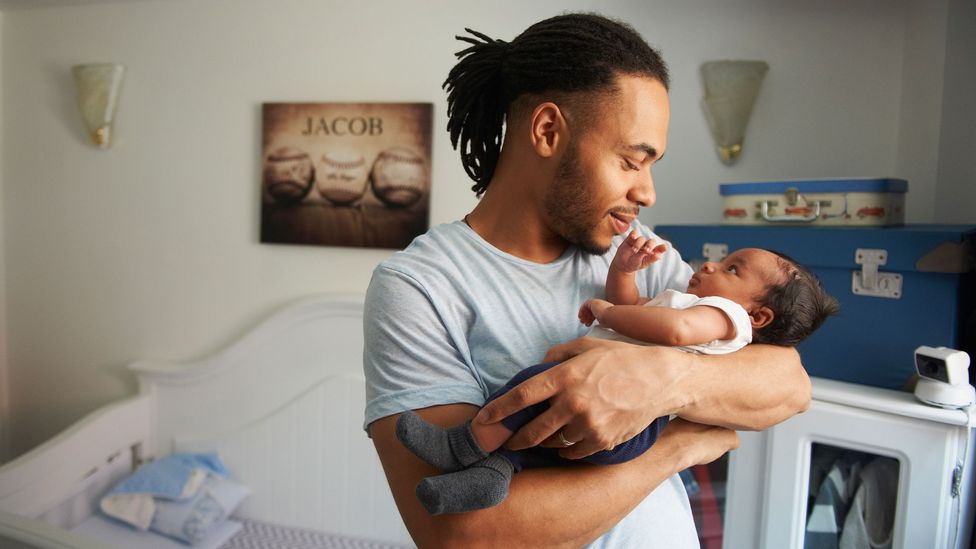
Warm, responsive caregiving has been associated with a range of benefits for babies and children, including more secure attachment (Credit: Getty Images)
For researchers similar those who found babies had lower cortisol when responded to overnight, the risk of stress is longer term. "Because early experiences of stress may programme the HPA (hypothalamic-pituitary-adrenal) axis to exist more stress reactive, increasing adventure of physical and mental wellness problems in later life, our results suggest that parenting in infant sleep contexts may play an important office in shaping how the child responds to stress across childhood," they wrote.
Plus, for pre-verbal infants, crying is one of their simply forms of advice, especially if they are trying to wake sleeping parents – leading to concerns virtually the touch on of an intervention specifically aimed to "extinguish" their cries. (Critics of cry-it-out note that this intention and end goal is one of the differences between a babe crying in sleep training versus in a situation where a babe is crying but a parent may be unable to provide their usual level of comforting, such as while driving.)
And if an infant is regularly waking frequently or having difficulty settling, it could be the sign of an underlying health issue like reflux or a tongue necktie, and then it's important to rule out whatsoever medical reasons for slumber problems first.
Sleep preparation critics also argue that we may but not be asking the right questions, or using the right scientific tools, to fully sympathise the potential risks.
"I retrieve [attachment and cortisol levels] are merely ii things that we've got tools to measure. So that's why they're picked," says Ball.
Different personalities
In that location is a further complicating gene: the degree to which a baby's private personality plays a part in whether they put themselves to sleep independently on their own, or whether sleep training is a success.
For example, inquiry has found that the more parents actively help their infants in going to sleep, the longer it can take those babies to larn to sleep independently. This is often interpreted to mean that you must exit your baby to it or sleep train for them to get an independent sleeper. But these were observational studies – so information technology could be, instead, that babies who need soothing to go to slumber have parents who answer by soothing them.
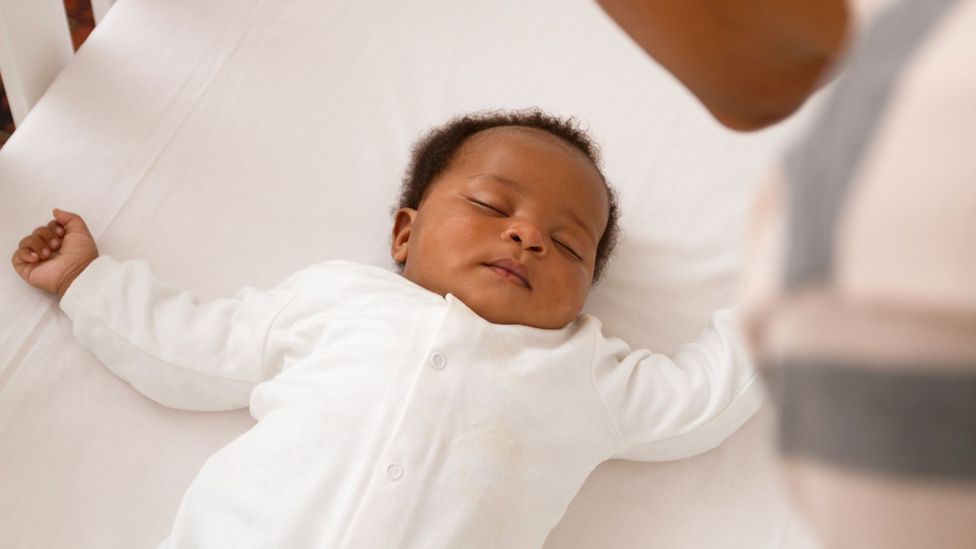
A babe's personality plays a part in whether they put themselves to sleep independently, or demand a caregiver's help and reassurance (Credit: Getty Images)
These differences in temperament may aid explain why slumber preparation (or, for that matter, suggestions such as "put your baby down drowsy simply awake") seems to work brilliantly for some families, who observe their babe barely grizzles before globe-trotting off, and don't work at all for others, whose infants might sob for hours and days on cease. The questionnaire of Canadian parents, for case, found that 25% reported using controlled crying for bouts of more than than two weeks at a time – 13% even tried for more than a month. (Mindell'south communication: "Stick with it for seven to 10 days, and after seven to x days, if it'due south not working, take a suspension. Don't just proceed going down that path.")
Information technology's as well worth noting that in their top-line results, studies commonly report on the average outcome, which doesn't testify the variation of every family's experience, specially those at the extremes – such as those who plant sleep training a keen success, or a total failure.
Given those individual differences, when talking about helping a child with whatsoever new skill, Siegel says, he encourages parents to consider the "zone of proximal evolution". The lower function of the zone is what the kid tin can practise on their own, while the top part is a more complex skill that yous must do with a child. "The best imparting of skills is within the zone. 'Permit me teach yous how to do it. Hither's how you brush your teeth.' 'Now, let's see if yous tin do information technology on your own. Oh, you really can't, okay.' 'Okay, at present you lot're a month older, and now you can'," he says.
Non anybody believes that falling comatose independently is a skill, pointing out that it normally happens developmentally with or without pedagogy and that, unlike, say, itch, it tin be something that comes and goes (a kid might self-settle at nursery only not at dwelling, or for a few months and and so stop). But if it is a skill, then it's most constructive to piece of work within that zone, not pushing a child by their edge, Siegel says.
So how do you know what the border is? Does 15 minutes of crying hateful the step you're trying to teach is too advanced for the child at that fourth dimension? An hour?
"I tin't reply as a scientist," says Siegel. "Merely intuitively, as a parent, equally a therapist, as an educator, if within five minutes, your kid is not finding a way to bring them into a calmer state, then their zone of proximal development has been pushed, I retrieve, beyond its limits. So you would want to requite them support."
The difficulty is that sleep preparation is based on the understanding that yous are "rewarding" a kid'southward crying if yous respond to them, education them that you will respond if they signal you – and then this is exactly what extinction-based programmes say not to exercise.
Family unit fatigue
Researchers tend to focus on sleep grooming's potential affect on babies – which makes sense, since they're the most vulnerable, helpless members of the family unit. Just sleep grooming manifestly affects the balance of the family unit, besides.
It's worth noting that it tin can become either fashion: some parents deeply regret using an extinction method with their little ones, for example, particularly if it goes confronting their instincts. On average, the Canadian questionnaire found, parents tend to find controlled crying "quite stressful" for both themselves and their kid. "You chance parents' mental wellness by overriding their instincts, considering I think that makes parents feel anxious about what they want to be doing (comforting their infant) versus what they end up doing (leaving them to cry). And then I think information technology's really difficult to know what you're risking on behalf of the baby," says Ball.
What y'all hear more frequently, however, is that sleep grooming tin help families, and some research backs this up. Hiscock's written report found that the mothers of sleep-trained babies were less likely to be depressed when the infant was two years old. Other inquiry has found that the fathers of 4-calendar month-olds with sleep bug had greater anger towards their babies and more depressive symptoms, and that infant slumber problems were associated with poorer wellness in both mothers and fathers.
Family Tree
A parent's mental health may in plough affect the infant's actual sleep patterns: one small written report using actigraphy found that depressed mothers were more than probable to have babies who have more than disturbed slumber. A parent'south poor mental wellness can as well put babies at a college run a risk of insecure zipper.
Hall'due south written report likewise looked at this element. While actigraphy showed that babies slept and woke similarly whether they were sleep trained or not, their parents' perceptions of the situation were very dissimilar. At six weeks, parents of but iv% of the sleep-trained infants versus 14% of the control-group infants reported that their child had a severe sleep problem. And the parents' levels of fatigue, slumber quality, and depressed mood all improved significantly.
While at that place are some caveats to the findings – such as that they may utilise mostly to mothers who already take symptoms of depression – many experts see this every bit a strong argument for using sleep training to ultimately boost the whole family unit's wellbeing.
"If we're not healthy and functioning as parents, information technology's very difficult to await afterward our children and give them the beloved and parenting that they need," says Hiscock. "At that place are some people who say we have to put the baby first and don't worry about the parent, and I just think that's wrong, because if you don't have a mum who's healthy and thriving, it's hard to accept a baby who'due south healthy and thriving. It's a relationship dynamic – it'southward not 1 or the other."
Academics who oppose slumber grooming concord that these factors are important. Their issue, they say, is with the fact that many parents ofttimes are simply advised to sleep train, without being told well-nigh nuances – such as that it doesn't work for every babe or that it oft needs to be repeated – and that they aren't presented with other options.
"I recollect it's often sold to parents who feel like they're in a tight spot, and they've got to slumber train their kid in gild to be able to survive. But actually, I think nosotros need to help them come up with other strategies fashion earlier they get to that crisis point," says Ball.
One strategy that both Brawl and James McKenna, the founder and director of the Female parent-Baby Behavioral Sleep Laboratory at the Academy of Notre Dame, have institute works for some low-risk families is bedsharing, or cosleeping. Pocket-sized studies have found that mothers written report having better slumber when bedsharing than when sleeping separately from their infants, even though objective measures discover only modest changes to their sleep, and while research has shown that while bedsharing infants wake more frequently, their total awake time doesn't differ from lonely sleepers. (The Lullaby Trust lists guidelines for safe bedsharing hither).
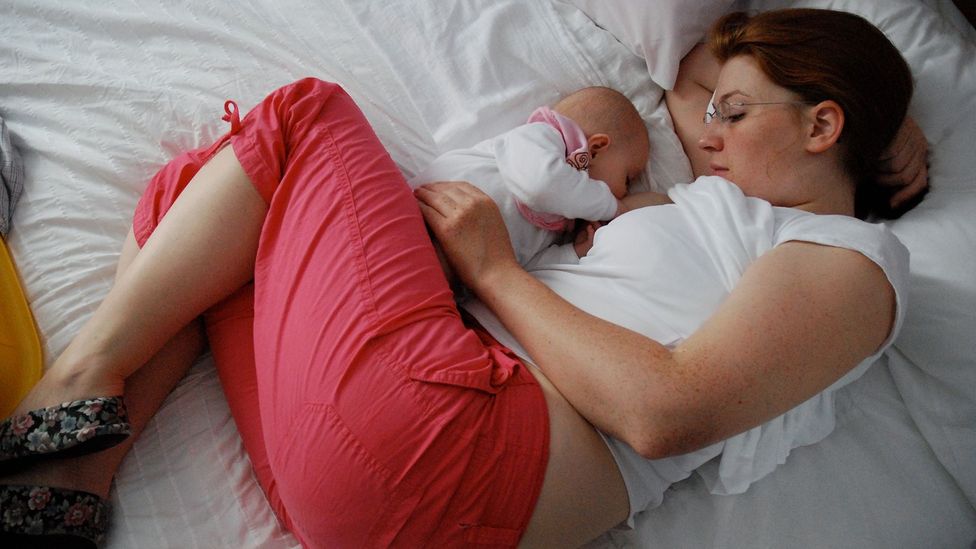
Some experts suggest bedsharing, or cosleeping, to low-risk families (Credit: Kathryn O'Donnell)
At that place are other strategies which researchers on both sides of the fence concur on. Implementing a bedtime routine is i. One review co-authored past Mindell institute that following a bedtime routine is linked to children falling asleep faster, waking less and sleeping for longer. Putting a routine in place even worked when information technology was the but slumber strategy families followed: 1 randomised controlled trial of 405 children aged vii to 36 months found that those who were randomly assigned a three-step routine of a bath, massage or lotion, and a serenity activeness like reading slept improve and longer than babies who were not assigned a routine.
Ball, who recently has worked with other researchers to adapt the Australian sleep programme Possums into a version for UK NHS practitioners, likewise points out that in that location are many means in which we frequently make things even harder for ourselves.
"We have this cultural obsession with getting children in bed at seven o'clock at night," she says. "But near babies are going to need another feed before their parents go to bed. And unremarkably when a baby falls comatose, the first block of sleep is the longest one of the night." That first 4 hours of sleep likewise is when we accept most of our deep slumber. "So if you align your period of deepest slumber with the time your infant gets its longest stretch of slumber by going to bed when they do, you're maximising the do good. Why are nosotros sitting downstairs watching telly? And when you say stuff like that to parents, some of them are like, 'We want some us time, nosotros want some child-complimentary time.' Well, so that's your pick. You lot're trading that off against slumber."
Giving parents more than back up and information may assist, likewise. Remember the intervention that was seen as helpful to the most mothers in Hiscock'south longitudinal study: "having someone to talk to". A higher percentage of parents also scored learning about what made their child's slumber worse and about normal sleep patterns as helpful than said the same of controlled crying – and receiving advice on how to wait after their own well-being and getting data about managing dummies was rated past more mothers than was camping out.
More broadly, critics as well point out that infant sleep is a societal result. Many modern families rely on two incomes and have footling or no parental leave – aspects that pressure parents to get solid night's sleep rapidly, oft long before an babe would be developmentally gear up to do it on their own, without prodding. It'southward common to meet calls for better (or any) motherhood or paternity get out among anti-cry-it-out circles.
Whether families choose to sleep railroad train or not, there is skillful news: eventually, with or without training, most children stop requiring a caregiver's assistance at night.
One report of more than four,000 children, for example, found that 71% of five-calendar month-olds who regularly woke at nighttime stopped nighttime wakes past 20 months, and 89% ceased by four.five years old. (Those who woke oftentimes equally infants were also more likely to wake equally pre-schoolers, but again, it'southward unclear how much of this is down to temperament: a infant who wakes could also exist more than probable to be a kid who wakes).
The bottom line on slumber preparation?
"It's only worth doing when parents want to practice information technology and run into it every bit an issue they need help with," says Hiscock. "I run into parents who might be up three, iv, five times a dark, simply they're happy to be, or they're coping and managing with that."
Mindell agrees. "If you're rocking a baby to sleep at four months of historic period, they're waking once a dark, it's working for the family, why would yous mess with success? Why would you exercise slumber preparation?
"We only actually recommend it when there'southward a problem," she says.
--
Bring together i one thousand thousand Future fans by liking united states on Facebook , or follow united states of america on Twitter or Instagram .
If y'all liked this story, sign upwardly for the weekly bbc.com features newsletter , called "The Essential List". A handpicked selection of stories from BBC Future , Civilisation , Worklife , Travel and Reel delivered to your inbox every Friday.
Source: https://www.bbc.com/future/article/20220322-how-sleep-training-affects-babies
Post a Comment for "Nobody Who Went on This Camping Trip Will Ever Feel the Same About Sleeping in own Bed Again 1"